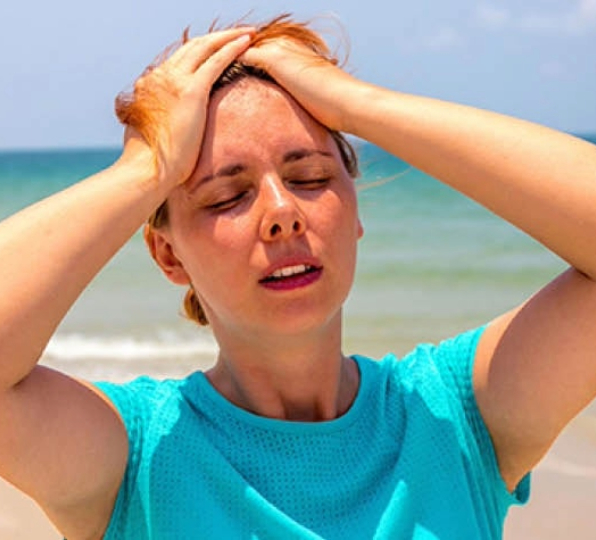Introduction:
When the body’s core temperature increases dangerously as a result of extended exposure to high temperatures and humidity, heat stroke is a serious and potentially fatal condition. To avoid complications, it’s critical to identify the warning signs and symptoms of heat stroke and act quickly. Let’s examine heat stroke’s causes, signs, preventative measures, and available treatments.
1. Causes of Heat Stroke
Heat stroke typically occurs when the body’s ability to regulate its temperature becomes overwhelmed, leading to a rapid increase in core body temperature. Several factors can contribute to the development of heat stroke, including:
- High temperatures: Excessive heat, especially in combination with high humidity, can hinder the body’s ability to cool down through sweating.
- Dehydration: Inadequate fluid intake or excessive sweating without adequate replenishment can lead to dehydration, further impairing the body’s ability to dissipate heat.
- Prolonged physical exertion: Engaging in strenuous activities in hot weather, particularly without adequate rest and hydration, increases the risk of heat stroke.
- Certain medical conditions: Individuals with pre-existing medical conditions such as heart disease, obesity, diabetes, or respiratory conditions may be more susceptible to heat-related illnesses, including heat stroke.
2.Symptoms of Heat Stroke
Heat stroke manifests through a range of symptoms, which can vary in severity. Common signs and symptoms include:
- High body temperature (usually above 104°F or 40°C)
- Rapid pulse
- Flushed or red skin
- Altered mental state or confusion
- Nausea and vomiting
- Headache
- Dizziness or lightheadedness
- Rapid and shallow breathing
- Loss of consciousness or seizures
3.Prevention Strategies
Preventing heat stroke involves taking proactive measures to stay cool and hydrated, especially during hot weather or when engaging in strenuous activities. Here are some preventive strategies:
- Stay hydrated: Drink plenty of water throughout the day, especially during outdoor activities, and avoid excessive alcohol and caffeine consumption, which can contribute to dehydration.
- Avoid peak heat hours: Limit outdoor activities during the hottest parts of the day, typically between 10 a.m. and 4 p.m., and seek shade or air-conditioned environments when possible.
- Wear appropriate clothing: Choose lightweight, loose-fitting clothing in light colors to reflect heat and sunlight, and wear hats and sunglasses for sun protection.
- Take breaks and rest: Pace yourself during physical activities, take frequent breaks in shaded or cool areas, and listen to your body’s signals of fatigue or overheating.
- Know the risk factors: Be aware of individual risk factors for heat-related illnesses, such as age, medical conditions, and medications, and take extra precautions accordingly.
4.Treatment of Heat Stroke
If someone exhibits symptoms of heat stroke, immediate medical attention is crucial. While awaiting medical assistance, take the following steps:
- Move the person to a cooler environment, preferably indoors or in the shade.
- Remove excess clothing and apply cool, wet cloths or ice packs to the skin to help lower body temperature.
- Encourage the person to drink cool water if they are conscious and able to swallow safely.
- Monitor vital signs and symptoms closely until medical help arrives.
5.Risk Factors
- Age: Infants, young children, and older adults are particularly vulnerable to heat stroke due to their decreased ability to regulate body temperature effectively.
- Certain medications: Some medications, such as diuretics, beta-blockers, and antipsychotics, can impair the body’s ability to dissipate heat and increase the risk of heat-related illnesses.
- Obesity: Excess body weight can hinder heat dissipation and increase the risk of dehydration and heat-related complications.
- Medical conditions: Individuals with conditions such as heart disease, diabetes, hypertension, and autoimmune disorders may have a higher risk of heat stroke, especially if their conditions are poorly controlled.
6.Recognition and Response
- It’s crucial to recognize the early signs of heat stroke and take immediate action to prevent further escalation.
- If you suspect someone is experiencing heat stroke, don’t delay in seeking medical help. Heat stroke can be rapidly progressive and life-threatening if not treated promptly.
- In addition to cooling measures, such as applying cold compresses and providing fluids, ensure the person’s airway remains clear and monitor their vital signs until medical assistance arrives.
7.Long-term Effects
- Heat stroke can have lasting effects on the body, even after the immediate crisis has been resolved.
- Complications of heat stroke may include organ damage, such as kidney failure or liver damage, as well as neurological deficits, including memory impairment or difficulty concentrating.
- Individuals who have experienced heat stroke should follow up with their healthcare provider for evaluation and monitoring to detect any lingering effects and prevent future occurrences.
8.Acclimatization
- Gradual exposure to hot environments allows the body to adapt and become more efficient at regulating temperature.
- When planning activities in hot weather or traveling to regions with high temperatures, acclimatize by gradually increasing exposure over several days and staying well-hydrated.
- Take extra precautions during the initial stages of acclimatization, as the risk of heat-related illnesses may be higher until the body adjusts to the new conditions.


Conclusion:
Heat stroke is a serious condition that requires vigilance, especially during periods of extreme heat and humidity. By understanding the risk factors, recognizing the symptoms, and taking proactive measures to prevent heat-related illnesses, individuals can stay safe and enjoy outdoor activities responsibly. Remember to stay hydrated, stay cool, and stay informed to beat the heat and protect your health year-round.












